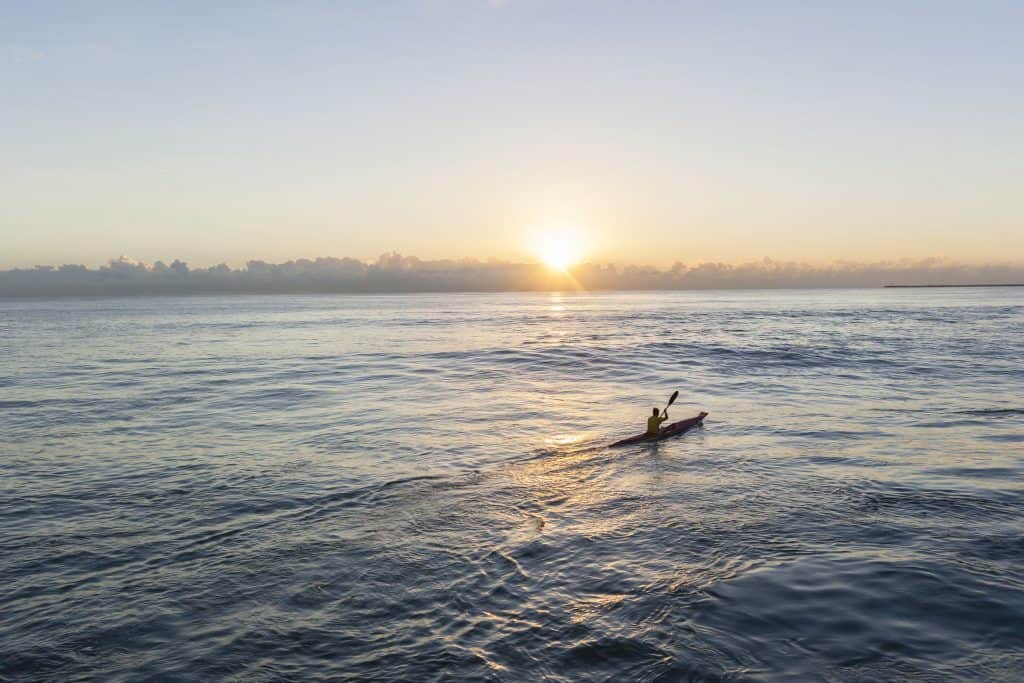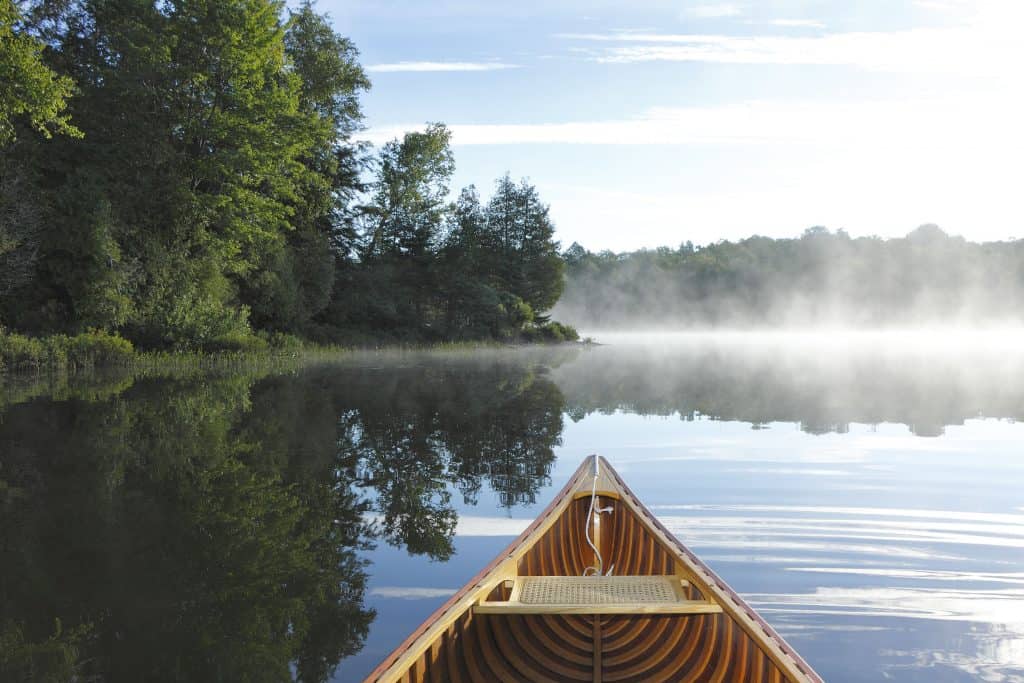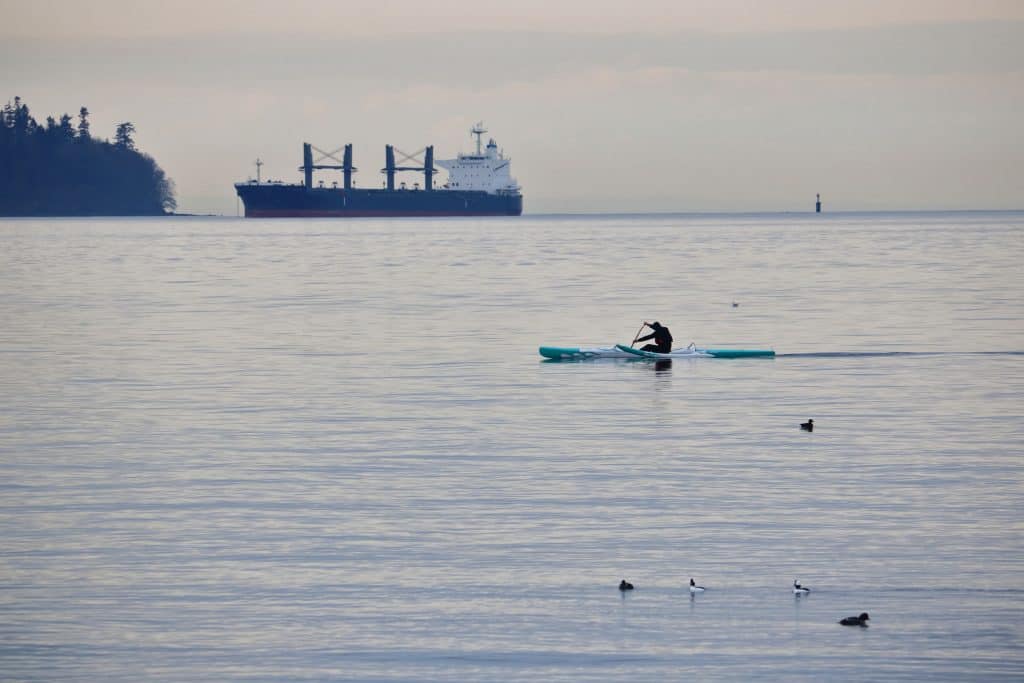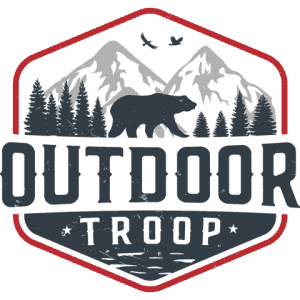
Paddling with two people is the way most canoers head out on the lake, and sometimes it’s hard to find a canoe being paddled by just one person. This is because people assume that it’s harder to paddle a canoe solo. However, it doesn’t have to be hard at all.
To successfully solo canoe, the canoer must kneel in the middle of the canoe and keep his or her knees in to control balance. To stop from spinning in circles, a canoer must make smooth, even strokes on both sides of the canoe, alternating sides.
Keeping these essentials in mind, a canoer can make a trip alone. It may be difficult at first, but once you get the hang of it, you may find it easier than canoeing with a partner.
How to Paddle Solo
The solo canoe trip is a serious undertaking. To learn how to successfully make an expedition all by yourself, we must start with the basics.
There will be 4 basic things to learn. These are:
- Body Position
- Hand Position
- “The Lean”
- Strokes
1. Body Position
Body positioning is critical whether you are paddling solo or tandem in a canoe. There are always 3 tips to keep in mind, despite whatever position you choose.
In almost all these positions you will be kneeling, so it’s important to have knee pads in the bottom of your canoe.
- Keep your knees low and/or down so that your torso moves your hips and your lower half. (Doing this gives you better balance, control, and power.)
- Maintain mobility. You want to make sure you can move, especially to heel the canoe when you steer around corners.
- No matter what position you choose, make sure that you are comfortable. Comfort is key.
Classic
The classic position or the Canadian Style is the most popular position for solo canoers. You kneel in the hull of the but, close to the middle. The bow seat gives support and kneeling in the hull allows you to get close to the canoe and the water, which gives you better control.
High Kneel/Two-Point
This position is related to the Classic because you kneel in the hull but instead of sitting back on your heels you are up off your knees. This provides you with a better forward reach and a more powerful stroke.
Three-Point/Spread
In this position, you also kneel but you spread your knees across the canoe. This provides good control across the canoe and helps it track straighter. This position is best when you will be cross stroking to move through the water.
Forward Position
Also, known as the Spread Two Point High Kneel, this position requires you to be up off your knees with your legs spread. This position is great for smaller canoes and helps with control in the wind and rough waves.
Sitting Cross Leg
This position allows you to sit on the seat of the canoe, in the stern. Remember to keep your knees lowered past the gunwale if you can. Your legs should still be spread and your ankles should be tucked and crossed underneath the seat.
Although kneeling on the bottom of the boat provides more power and balance, you still get good power and balance when sitting on the seat.
Let out, Leg Down
You are also sitting on the seat in this position but with your paddling knee down in a kneeling position. The other leg should be stretched out in the canoe. This helps move the canoe along powerfully. This does limit balance and control but increases power.
Racing
This is the position for max power and speed. This is a difficult technique to perfect and you need strong legs to do it. You don’t have great balance or control but the speed is undeniable. This is much like the Leg Out, Leg Down but instead of having your leg down it is up at a right angle like you’re proposing.
Transverse
This position has the paddler facing the side of the canoe with your knees to whatever side you’re paddling and your legs and feet tucked underneath you. This isn’t a very popular position and is difficult to perfect.
Transverse/Knee Thrust
Also, known as the “Gunwale Kneel”, it is the same as the transverse position but instead of both knees on the floor of the canoe, the paddling knee is up at a 90-degree angle. Again, this isn’t a very popular position but is mainly used in racing circumstances.
Casual/Sleeper
This position is just fun or used for resting your knees. It is done by just laying down on the bottom of the canoe and pushing the paddle across either side. This position is great if you want to watch the sky or even take a nap. Just don’t forget to keep your paddle in your canoe if you plan on falling asleep.

2. Hand Position
In case you are unaware of how to properly hold a canoe paddle, here is a video on how to do so.
Having your bottom hand higher on the shaft helps extend your reach. This gives you more leverage when steering which gives more effort and efficiency.
You always want to swing your paddle out to the front of the boat. This will keep you going in the right direction. Dragging it back to the front after a backstroke will get you spinning in circles.
In rough wind and water, you’ll want to extend your reach because that helps keep you in control. Leaning forward also increases leverage and shifts the weight forward which reduces the wind effect.
3. “The Lean”
“The Lean” is an essential part of canoeing solo. This is why kneeling on the bottom of a canoe is such a prime position for solo canoers. Kneeling in the canoe allows you to lean to the side that you’re paddling on.
This allows one end of the canoe to be raised from the water and opens it up to become like a sail to a gust of wind. Kneeling in the center of your canoe helps keep the canoe centered, but as you lean and turn with the canoe it helps create smoothes turns and glides through the water.
A slight lean to the paddle side lifts the bow and stern out of the water which creates a shorter waterline and a more manageable canoe for a soloist to handle.

4. Strokes
Although paddling can be as simple as one stroke on one side and one stroke on the other, turning and steering and dealing with rough water requires a bit more technique.
These strokes allow for different techniques that can help with sharp turns, quicker speeds, more power, and better efficiency.
The J Stroke
The J Stroke is the most popular canoe stroke. It is a corrective stroke but can be used for a quick forward stroke or a cross-forward stroke combination to get yourself moving.
- To begin the J Stroke reach the paddle forward until your bottom arm is fully extended.
- Dip the paddle into the water until the blade is fully submerged.
- Pull the paddle back until your lower hand is slightly behind your torso.
- Rotate the paddle ninety degrees so that the face of the blade is parallel with the side of the canoe.
- Push the blade out away from the canoe and pulling the top of the paddle in the opposite direction.
- Pull the blade of the paddle out and repeat the steps.
Usually, because the J Stroke is a corrective stroke, you may only need to use this stroke once or twice every three or four strokes to keep the canoe in a straight line.
The J Stroke can be a little difficult to perfect so here are some tips on achieving a great J Stroke.
- For Better Power – Plant the paddle blade in the water with the shaft vertical. Then, pull the paddle back in a straight line.
- For Better Transition – As the paddle passes your body, twist your hands down and out. Remember your thumb at the top of your hand points toward the water, the blade rotates and then lies parallel to the direction you’re going.
- For Better Correction – You should use your bottom hand to pry the blade away from the boat. To tame a bow drift you can rudder your canoe in the water, otherwise, you might need a harder push.
- For Better Return – If you need more correction just drag the blade tip through the water for a few inches as you bring your paddle forward.
Here’s a video about how to do the J Stroke properly.
The Sweep Stroke
The Forward Sweep Stroke is used by solo paddlers to turn the boat to the offside. First, plant your blade in the water as far forward as you can and with the shaft as horizontal as possible. This means your control hand is in front of your stomach and the shaft arm is fully extended. Then, sweep a wide arc out to the side of the canoe and stop just before the blade hits the stern. You will use torso rotation for this move.
The Reverse Sweep Stroke is used by solo paddlers to spin the canoe. The reverse is the same technique as the forward sweep stroke. Plant your paddle as far back in the water as you can while keeping the shaft as horizontal as possible. So again, your control hand will be in front of your stomach and your shaft hand will be towards the stern.
Make sure to turn your torso aggressively with both these strokes to keep your hands with your field of vision. Keep your hands low and maintain a 180-degree sweep. Your torso should do all the work and your arms should stay in a fairly fixed position.
The Draw Stroke
The draw stroke is meant to pull your canoe sideways towards your paddle side. Your thumb should point towards the stern. Reach outwards while leaning your canoe towards the paddle and catch the blade to keep the paddle as vertical as possible, then pull your canoe towards the paddle.
If you draw forward from the center the canoe will turn the bow of the canoe towards the paddle, and it works the same for a draw stroke for the rear.
Here’s the step by step instructions for this stroke along with a video about how to do it.
- Rotate your torso so your chest and soldiers are facing the direction you want to go.
- Reach your paddle out to the side about a foot or so away from the boat. Keep it parallel with your hips with the face of the blade facing you.
- Draw your hip and paddle together by pulling the boat towards you.
- Stop about 2/3 inches away from the canoe.
- Then recover the blade. You could slice the blade back toward the back of the boat or roll your wrists forward while keeping the paddle submerged and slice the blade through the water back to the original position.
The Pry Stroke
The pry stroke pushes the canoe away from the paddle side. The easiest way to perform this stroke by placing the shaft of the paddle against the side of the gunwales. Then, lean the canoe towards the paddle side and slice the paddle into the water at and angle.
For this stroke, you can use the weight of your body to increase power. Like the draw stroke, the pry stroke will push your bow or stern away from the paddle. The Pry Stroke is the opposite of the Draw Stroke.
The C Stroke
The C stroke is great for a solo canoer in a tandem canoe. This stroke is actually a combination of three different strokes which allows more control of over the canoe when paddling on one side of the boat. It’s called a C Stroke because you make a C under the water.
The C stroke is a combination of the forward stroke, the draw stroke, and the pry stroke. You start with a dry stroke then blend it into a forward stroke (which is just a regular stroke), and then finish with a pry stroke. This stroke will turn the canoe towards the paddle, then move the boat away from the paddle side and then push the bow towards the paddle side.
Stationary Bow Draw
A Stationary Bow Draw is a stroke that only works when you have forward momentum. This stroke helps a solo paddler to turn the canoe to the on-side.
Place the paddle just ahead of your knee with the shaft help as vertical as possible and with your torso rotated to face the paddle. Both arms should stay lightly bent with the shaft arm’s elbow kept close to your body and your control hand should be held in front of your forehead.
Then turn your control hand slightly so that your thumbs point toward your forehead. The face of the paddle should now face the bow of your canoe. Hold fast and don’t let go of the paddle or you can capsize.
CrossBow Stroke
Much like the Stationary Bow Draw, the Cross Bow Draw is a stroke primarily used by a solo paddler to turn the boat on its offside. This stroke involves lifting the paddle over the canoe to your offside and then planting it deeply in the water as vertical as possible (about a foot and a half away from the canoe in front of your knees). This position does require you to rotate your torso aggressively.
From this position, you’ll twist the paddle so the face faces the bow of the canoe. Your control thumb so it’s facing away from you. This helps you catch a lot of water when you’re moving forward. This again creates a great deal of force so don’t let go of your paddle.
Pro Tip: Use the Wind
Trying to maintain control of your canoe with heavy wind can get frustrating. If this happens, you can give in and use the wind to help gain control. The light end of the canoe, usually the bow, will always swing downwind in gusts. So the easiest way to head in the direction you want is to safely turn around in the canoe.
This makes the bow the heavy end and will keep it from being controlled by the wind. This allows you to put more effort into your strokes because steering will be easier. Then, once you can you can turn back around and start paddling normally.
When the bow end of the boat is directed by wind, this is called weathercocking. If you don’t feel comfortable about turning around and the wind is coming from your offside, you can use more aggressive J Strokes to keep your course.
If the wind is coming from your onside you can use regular forward strokes or sweep strokes to keep running straight,

Solo canoeing really isn’t difficult. It is just like any other canoeing activity, you just need practice. Make sure that before you head out on your own you have plenty of food and water, the right safety equipment, and let someone know where you are going and how long you’ll be there so that if something happens some will know where you are. Don’t overthink it! Just practice and be safe, and you’ll have a great time.
